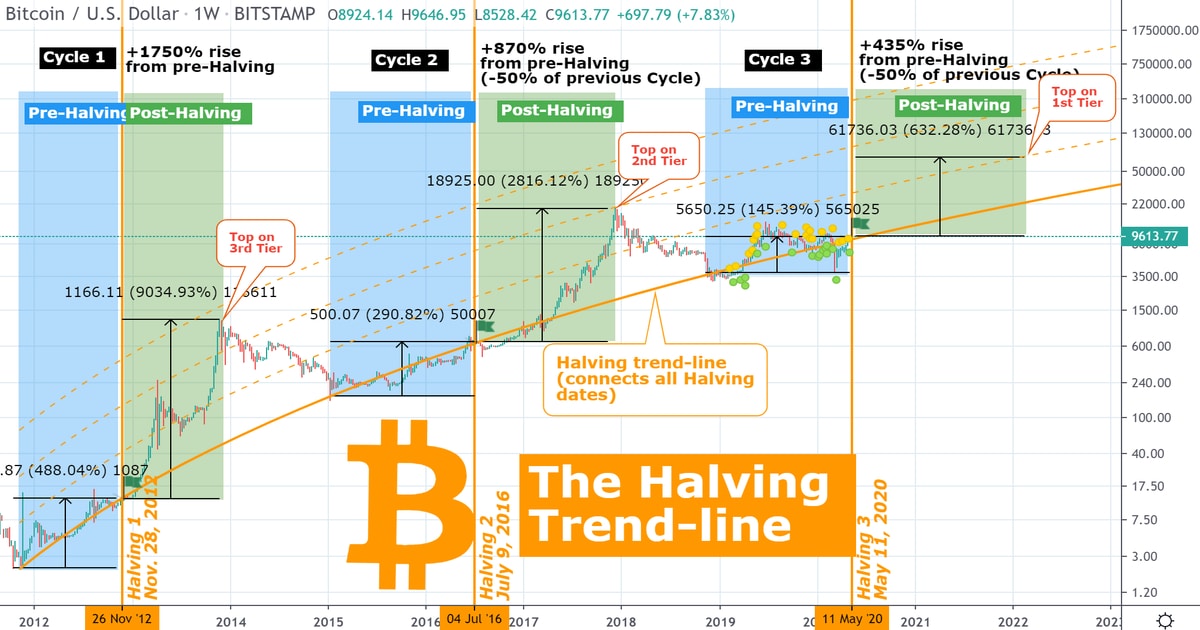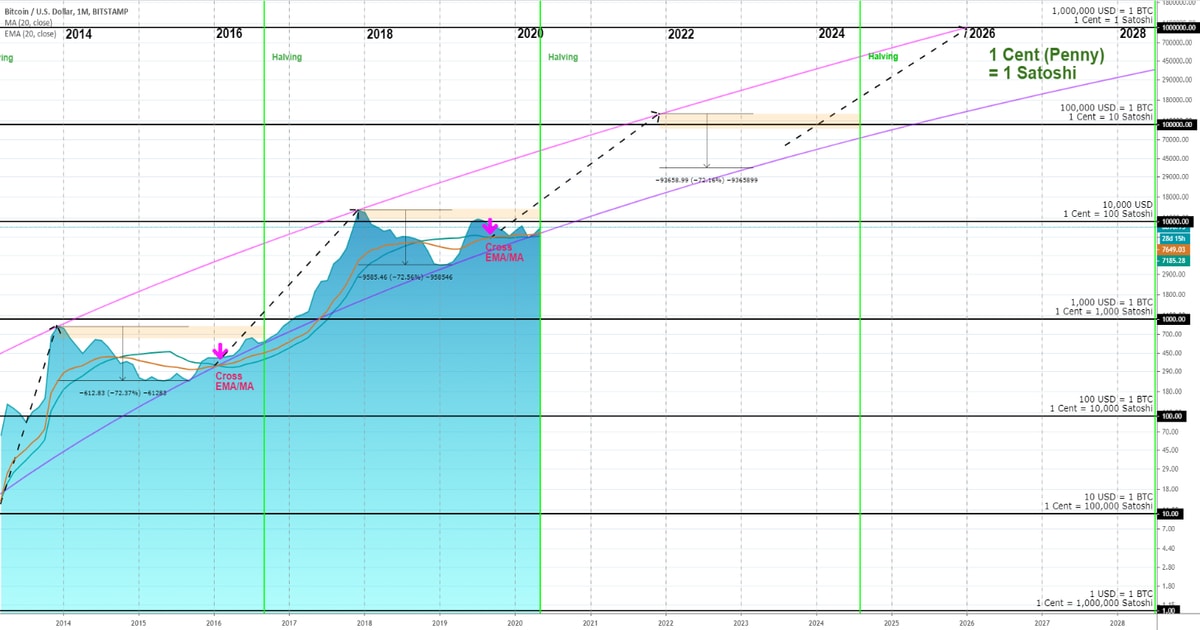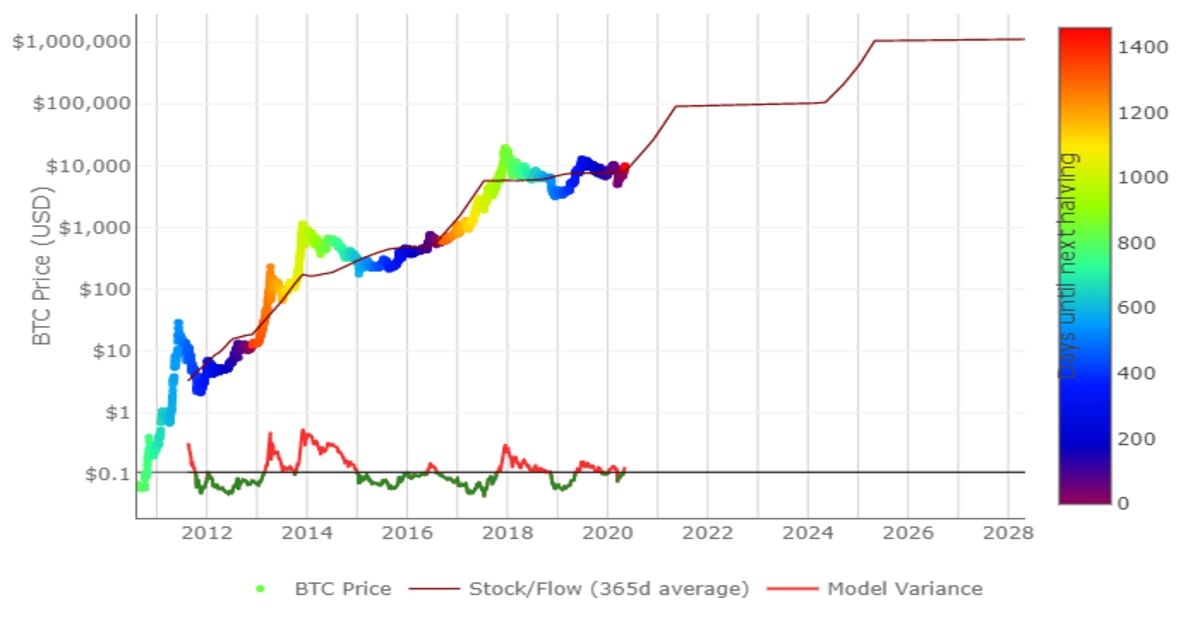Bitcoin Price Breaks $10,000 Flirting with High Resistance of Supply – Understanding the Stock to Flow Model

Bitcoin has taken off this week, moving to $10,000 and firing up the market in euphoria. With only one week from halving, The Bitcoin price has now deleted all its coronavirus crash losses, up practically 40% since January 1st—and putting it on target to be one of the year's best performing resources. With the Bitcoin halving approaching, some have cautioned the Bitcoin cost is set out toward a bluff edge, and some are cautioning Bitcoin could fall after following week's bull rush, but let's take a look at the Bitcoin halving structure to understand how Bitcoin can move in future by analyzing its historical trends.
The technical analysis shows pre-halving and post-halving market structure from 2012 to 2022. In 2012 (Cycle 1), the price of Bitcoin increased by +488% in the pre-halving phase and recorded a +1750% rise after pre-halving on November 28th, 2012. In 2016 (Cycle 2), the price of Bitcoin increased by +870% from pre-halving. Currently, in Cycle 3, it is expected that the price of Bitcoin is predicted by a +435% rise after halving takes place in 2020.

Understanding Stock to Flow Model
What is the Stock to Flow model?
In basic terms, the Stock to Flow (SF or S2F) model is an approach to quantify the abundance of a specific asset. The Stock to Flow proportion is the measure of an asset held for later use isolated by the sum it is delivered every year.
The Stock to Flow model is applied to standard assets. For example, gold. While the evaluations may shift, the World Gold Council gauges that around 190,000 tons of gold has ever been mined. This sum (i.e., the all-out flexibly) is the thing that we can allude to as the stock. In the meantime, there are around 2,500-3,200 tons of gold mined every year. This sum is the thing that we can allude to as the stream.
We can compute the Stock to Flow proportion utilizing these two measurements. It shows how much flexibly enter the market every year for a given asset comparative with the total supply of the asset. The higher the Stock to Flow proportion, the less new supply enters the market comparative with the all-out flexibly. In that capacity, an advantage with a higher Stock to Flow proportion should, in principle, hold its worth well over the long haul.
Interestingly, consumable products and mechanical wares will ordinarily have a low Stock to Flow proportion. Why would that be? Since their worth regularly originates from them being wrecked or devoured, the inventories (the stocks) are generally just there to cover requests. These assets don't have high an incentive as assets, so they will, in general, work ineffectively as investment resources. In some excellent cases, the cost may rise if there's an expectation of lack later on, yet something else, creation stays aware of the interest.
Note that shortage alone does not imply that an asset should be valuable. Gold, for instance, isn't too uncommon – all things considered, there are 190,000 tons accessible! The Stock to Flow proportion proposes that it's essential because yearly creation contrasted with the current stock is generally little and consistent.

What is the Stock to Flow proportion of gold?
Verifiably, gold has had the most noteworthy Stock to Flow proportion out of valuable metals. In any case, what amount is it precisely? Returning to our past model – how about we separate the all-out flexibly of 190,000 tons by 3,200, and we get a Stock to Flow proportion of ~59. This reveals to us that at the present creation rate, it would take around 59 years to mine 190,000 tons of gold.
It merits remembering, however, that the evaluations for how much new gold will be mined every year are only that – gauges. On the off chance that we increment the yearly creation (the stream) to 3,500, the Stock to Flow proportion diminishes to ~54.
While we are grinding away, why not compute the complete estimation of all gold that has been mined? This, somehow or another, might be contrasted with the market capitalization of cryptographic forms of money. On the off chance that we take a cost of about $1500 per ounce of gold, the complete estimation of every single gold comes to around $9 trillion. This seems like a ton, however, on the off chance that you'd join everything into one 3D square, you could fit that 3D shape into a solitary football arena!
Equivalently, the most elevated all out estimation of the Bitcoin organize had been around $300 billion in late 2017 and is floating around $120 billion at the hour of composing.

Source: Look into Bitcoin
Stock to Flow and Bitcoin
On the off chance that you see how Bitcoin functions, it won't be hard for you to comprehend why applying the Stock to Flow model to it may bode well. The model treats bitcoins similarly to rare products, similar to gold or silver. Gold and silver are frequently called a store of the significant worth of assets. They, in principle, ought to hold their incentive over the long haul because of their relative shortage and low stream. Besides, it's tough to expand their flexibly inside a brief timeframe necessarily.
As indicated by the promoters of the Stock to Flow model, Bitcoin is a comparable asset. It's rare, moderately expensive to deliver, and it's most extreme flexibly is topped at 21 million coins. Likewise, Bitcoin's gracefully issuance is characterized on the convention level, which makes the stream unsurprising. You additionally may have caught wind of the Bitcoin halvings, where the measure of new flexibly entering the framework is split every 210,000 squares (around four years).
Image via Shutterstock

